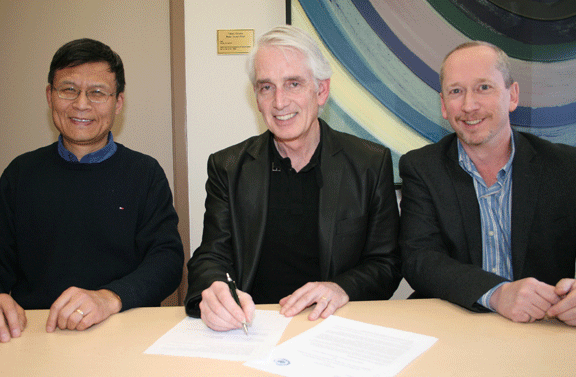Streamlining student transfers
The marriage of diplomas with degrees has not always been harmonious or without critics. Arts and Science Dean Peter Stoicheff is working to change that, moving aggressively to create new transfer agreements and dispelling stereotypes along the way.
By Colleen MacPherson The college has 11 transfer agreements currently in place, with at least 15 more being discussed. A new position, transfer articulation coordinator, was also established in 2013 to manage current agreements and develop relationships between the college and other institutions.
The college has 11 transfer agreements currently in place, with at least 15 more being discussed. A new position, transfer articulation coordinator, was also established in 2013 to manage current agreements and develop relationships between the college and other institutions.Although details vary, these agreements essentially allow students to complete two years at one institution and get full credit for these years when transferring to a similar program at the U of S. In the case of technical institutions or community colleges, this often means students receive a diploma or certificate and then can earn a degree with only two additional years of study.
The College of Arts and Science is currently home to nearly 3,500 transfer students—students who come to the college after spending time in other colleges or institutions. That number comprises nearly 21 per cent of the university's total undergraduate population.
Without transfer agreements, moving from one institution to another can be cumbersome, as students do not receive credit for some of their previously completed courses.
"It can become so bureaucratically difficult that, regardless of the result, (students) don't want to go through the process," said Stoicheff. "Given that there is so much interest in transferring here, we feel we should identify the programs where it can be really simple and straightforward."
Stoicheff said transfer students have, statistically, performed well academically in the college. And because the college has capacity for more students in the third and fourth years at the undergraduate level, it makes sense to actively identify programs where transfer agreements could potentially fit.
"It's not anything goes. The transfer articulation agreements we are creating are meaningful and strategic ones, and they have to maintain the academic integrity of the programs students are moving into," he said.
"But students who come from SIAST or a community college are extremely well qualified … they know how to complete something and they tend to be educationally very mature. So if they want to come here, why would we make it difficult for them?"
In addition to seeking new agreements with diploma or certificate-granting institutions, Stoicheff is also looking to augment the college's international presence and relations with other universities around the world.
The Department of Biology signed a new 2 + 2 transfer agreement with Beijing's Capital Normal University (CNU) in February, which allows students to earn a BSc degree by studying two years in CNU and two at the U of S.
The college is also about to sign its first-ever renewal of a block transfer agreement, a 2 + 2 agreement with SIAST's Chemical Technology Program and the Department of Chemistry.
Transfer agreements have historically been a divisive issue, with many believing the academic gap between technical institutions and universities is too wide to bridge. Stoicheff, however, believes "the gap isn't very wide at all," again pointing to statistics showing the success of previous transfer students in the college.
The increased marketability of students with both a diploma or certificate and degree is another reason Stoicheff says it is important to move decisively on transfer agreements. And his thinking on the matter goes both ways.
"Just as it's a really formidable combination for someone to have diploma or certificate and then get a degree, I think the reverse is also true. If you have a degree from here and you add on a certificate or diploma from a community college or a SIAST, that's a really good thing to do as well."
Kirk Sibbald is communications officer in the College of Arts and Science

